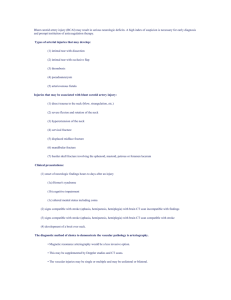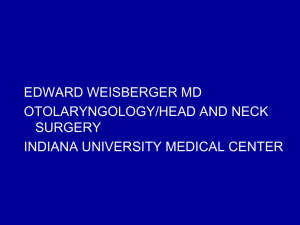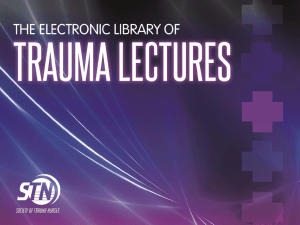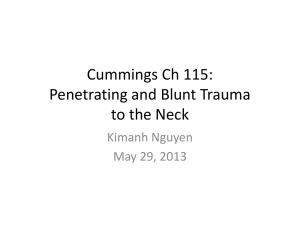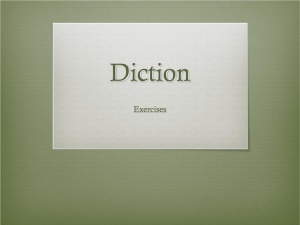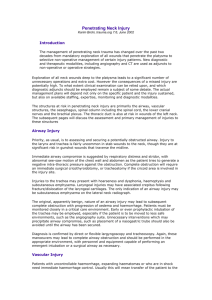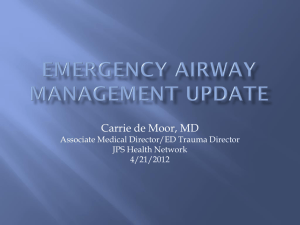Blunt and penetrating neck injury
advertisement
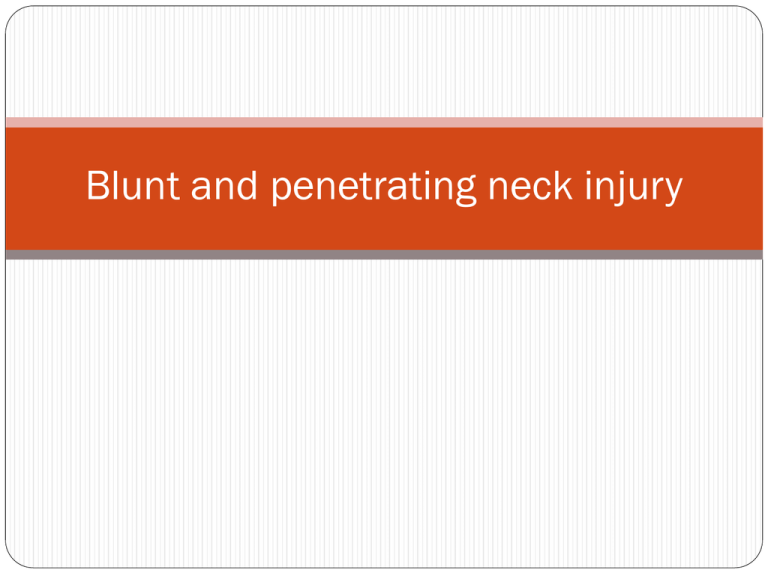
Blunt and penetrating neck injury reference B.J.Bailey ,et al. Head & Neck surgery Otolaryngology.4th edition.2006 Charles W. Cummings, et al, Cummings Otolaryngology, Head & Neck Surgery, 5th ed. 2010 D.V. Feliciano ,et al. Trauma, 6th Edition.2008 www.google.com Zones of the Neck . Zone I: thoracic inlet to cricoid cartilage Zone II: cricoid cartilage to the angle of mandible Zone III: angle of the mandible to skull base CLASSIFICATION Zone I From the clavicles to the cricoid Trachea Lungs Proximal carotid and vertebral arteries Jugular veins Thoracic Vessels Esophagus Superior Mediastinum Thoracic Duct Spinal Cord Brachial Plexus Zone II From cricoid to angle of mandible Trachea Larynx Carotid and vertebral aa. Jugular Vein Esophagus Spinal Cord Zone III Angle of mandible to base of skull Distal carotid and vertebral arteries Pharynx Spinal cord PENETRATING NECK TRAUMA Presently, penetrating neck injury comprises 5% to 10% of all trauma cases. All penetrating neck wounds are potentially dangerous and require emergency treatment. Physical properties of penetrating objects handgun Rifle Shotguns Knife and stab injuries Physical properties of penetrating objects Kinetic energy= ½ mv2 m = mass V = velocity Degree of wound Firearm Low velocity ( < 1,000 ft/sec) handgun 300-800 ft/sec high velocity ( > 1,000 ft/sec) shotgun 1,200 ft/sec , rifle 2,200 ft/sec Physical properties of penetrating objects Gunshot wound tissue injury from 2 mechanism Direct tissue injury Temporary caviation Low velocity tissue damage High velocity tissue loss KNIFE and STAB Knife, ice-pick, cut-glass, or razor-blade more predictable pathways single-entry wound may be from multiple stab wounds cervical stab wounds have a higher incidence of subclavian vessel laceration because stabbings to the neck often occur in a downward direction with the knife slipping over the clavicle and into the subclavian vessels. spinal injuries, neck stab wounds have a lower incidence than cervical bullet wounds. Genaral trauma principle A : airway with C-spine control B : breathing and ventilation C : circulation D : disability and neurologic status E : exposure and evaluation other injury A : Airway Most casecarefully intubated transorally If C –spine injury is suspected intubate with neck stabilized Unstable airway with sig. bleed or edema in oral cavity or pharynx cricothyroidotomy or urgent tracheostomy A : Airway Multiple blind intubation attempts will risk enlarging a lacerated piriform sinus wound and extending it iatrogenically into the mediastinum. Tracheal tear may be exacerbated by extending the neck A : Airway Obvious tracheal injury carefully intubated through entry wound using armored/reinforced ETT B: Breathing Administer high-flow oxygen Monitor : pulse oximetry Difficulty ventilation may upper airway or thoracic injury Unequal breath sounds & asymmetric chest movement inadequate ventilation Pneumothorax Hemothorax Tension pneumothorax C : Circulation Control active bleeding with direct pressure Do not clamp bleeding vessels Subsequent injury to vascular or nervous structure Avoid placing IV access at a location where the IV fluid would flow toward the site of injury Avoid inserting NG tube at the initial resuscitation : gag & retching cause dislodge a clot & cause hemorrhage D : Disability Neurodeficit indicate directed nerve or spinal cord injury cerebral ischemia cause by carotid artery injury Need rapid sedation and paralysis for intubation Immobilize the cervical spine in a neutral position Vital structures of the neck four groups: the air passages (trachea, larynx, pharynx, lung); vascular (carotid, jugular, subclavian, innominate, aortic arch vessels); gastrointestinal (pharynx, esophagus) neurologic (spinal cord, brachial plexus, peripheral nerves, cranial nerves [CNs]) SYMPTOM Airway Vascular System Reparatory distress Hematoma Stridor Persistent bleeding Hemoptysis Neurologic deficit Hoarseness Absent pulse Tracheal deviation Hypovolemic shock Subcutaneous emphysema Bruit Sucking wound Thrill Change of sensorium From Stiernberg C, Jahrsdoerfer RA, Gillenwater A, et al. Gunshot wounds to the head and neck. Arch Otolaryngol Head Neck Surg. 1992;118:592 SYMPTOM Nervous System Hemiplegia Quadriplegia Coma Cranial nerve deficit Change of sensorium Hoarseness Esophagus/Hypopharynx Subcutaneous emphysema Dysphagia Odynophagia Hematemesis Hemoptysis Tachycardia Fever From Stiernberg C, Jahrsdoerfer RA, Gillenwater A, et al. Gunshot wounds to the head and neck. Arch Otolaryngol Head Neck Surg. 1992;118:592 Mandatory versus Elective Exploration Immediately life threatening: massive bleeding, expanding hematoma, hemodynamic instability, hemomediastinum, hemothorax, and hypovolemic shock.Immediate surgical exploration Hemodynamically stable ,non–life-threatening features can undergo thorough imaging investigations to determine the extent of injury. Injury Zone 1 injury Below cricoid, dangerous area Protect zone bony thorax and clavicle Motality rate 12 % Potential for injury to great vessel and mediastinum Mandatory exploration : not recommend Angiography and esophageal evaluation: usually suggest > 1/3 no symptom at presentation Zone 1 injury Esophageal evaluation endoscopy , contrast esophagogram Contrast medium Barium- based Gastrografin ( meglumine diatrizoate) Combination tests should not miss an njury CT scan Determine the path of projectile Zone 2 injury Largest zone,most common site of trauma 60-75% Between angle of mandible & inf border of cricoid cartilage Isolate venous injury & pharyngoesophageal injury most common structure missed clinically All pt. are admitted for observation and 24 hr re-evaluation 50% of death hemorrhage from vascular structure Zone 2 injury Symptomatic neck exploration Asymptomatic Directed evaluation and serial exam Arteriography, Laryngotraheoscopy flexible esophagoscopy barium swallow Requires adequate physician ,24 hr facility prepared for emergency testing and Surgery Zone 3 injury Superior to angle mandible to skull base Potential for injury to major blood vessel and CN near skull base Arterial injury may be asymptomatic at presentation Surgical exposure and control bleeding may be difficult amenable to definitive treatment by an interventional radiologist Vertebral artery injury appear to be relatively rare Should be imaged if bullet path is near the vertebral column Four vessel angiography Angiography : Zone1 & 3 Routine preoperative arteriography in stable case Surgical approach is more difficult than zone 2 If wound involve both side of neck ( stable but symptomatic) four vessel angiography Angiography : Zone1 & 3 Angiography : Zone2 Easy accessible,low risk for exploration Certain indication for an angiogram in zone 2 Stable pt. who has persistent hemorrhage Neurodeficit compatible with adjacent vascular structure damage eg. Horner’s syndrome , hoarseness Need exploration Positive arteriography Negative arteriography but positive clinical sign Asymptomatic in zone 2 Controversy, No sig difference btw. Clinical exam & angiography CTA fast ,minimal invasive in hemostatic stable Management of vascular injury zone 1 Vascular perforation requires thoracic Sx Mediastinotomy extension or formal lateral thoracotomy Management of vascular injury zone 3 Injury at the skull base can be temporalize by pressure Mandibulectomy in midline Temporaly arteral bypass of carotid artery Management of vascular injury All vein in the neck can be safely ligated to control hemorrhage injury both internal jugular vein try repair All external carotid artery suture ligation Good collateral circulation Management of vascular injury Common carotid artery/internal carotid artery in zone 2 Approach along SCM if no pulsating followed retrograde from facial artery/sup thyroid artery Technique of vascular repair End to end or autogenous graft reccomended when stenosis is evident by arteriography Ligation of common or internal carotid a.reserved for irreparable injury and in pt, who are in a profound coma state Delayed complication from unrepaired vascular injury Aneurysm formation Dissecting aneurysm AV fistulas Technique of vascular repair Intervention radiologists used angiography technique to treat vascular injury Embolization Zone 3 high incidence of multiple vascular injury event Complication of intervention angiography Blood vessel injury Inadvertent balloon detachment Ischemic events Pseudoaneurysm formation Treatment failure Pharynx and esophageal injury Clinical sign and symptom neck exploration subcutaneous emphysema Hematemesis Hypopharyngeal blood >50%of Pt. asymptomatic at presentation Combination of esophagoscopy and contrast esophagography Most sensitive for detected injury Delayed explore & repair beyond 24 hrs after injury poorer outcome Digestive tract evaluation Possible esophageal perforation gastrografin swallow Barium : extravasation & distort soft tissue plane and toxic Digestive tract evaluation Flexible esophagoscopy Missed perforation : cricopharyngeus, hypopharynx Negative endoscopy but air leak in soft tissue mandatory neck explore Infiltrate methylene blue : localize injury size Combination of flexible and rigid endoscopy Exam entire cervial and upper esophagus No perforation missed Digestive tract evaluation Suspicious pharyngeal perforation NPO for several days S&S : fever , tachycardia,widening of mediastinum Repeat endoscopy or neck exploration Esophageal injury in the early phase Two layer closure with wound irrigation Debridement Adequate drainage Extensive esophageal injury lateral cervical esophagostomy Digestive tract evaluation C-spine fx omitted rigid esophagoscopy Clinical exam F/U exam frequently Monitor V/S Observe period 48-72 hrs Penetrating of hypopharynx Superior to the level of arytenoid cartilage IV ABO NPO ทางปาก 5-7 days Primary closure not always necessary Inferior to the level of arytenoid cartilage Dependent portion Exploration with primary watertight closure Use absorbable suture with drainage of adjacent neck space NPO 5-7 days Treat liked esophageal injury Treatment Conservative Medical therapy Adequate ventilation & oxygenation Fluid resuscitation Monitor neurolodic status Pain control ABO Tetanus prophylaxis Treatment Surgical approach Zone 1 Median sternotomy Thoracotomy Zone 2 Collar incision Apron incision Zone 3 Consult neuroSx Blunt neck trauma motor vehicle accidents and sports result in laryngeal, vascular, and digestive injury easily underdiagnosed because their onset can be delayed occult cervical spine injury Blunt neck trauma careful observation : delayed onset slow progression of airway edema airway obstruction may not occur until several hours after the injur CT may be helpful to determine degrees of injury to the larynx and vessels Blunt neck trauma Blunt injury to the cervical vessels can lead to thrombosis, intimal tears, dissection, and pseudoaneurysm Treatment options for blunt artery injuries are based on the mechanism, type of injury, and location Blunt neck trauma Treatments for blunt artery injuries include surgery, anticoagulation, and observation. Surgical intervention for blunt vascular injuries includes ligation, resection, thrombectomy, and stent placement
